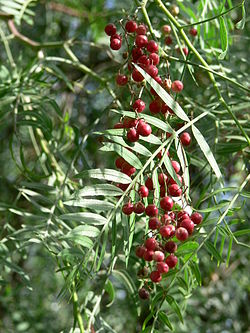コショウボク
表示
| コショウボク | ||||||||||||||||||||||||
|---|---|---|---|---|---|---|---|---|---|---|---|---|---|---|---|---|---|---|---|---|---|---|---|---|
 実のついたコショウボク
| ||||||||||||||||||||||||
| 分類(APG III) | ||||||||||||||||||||||||
| ||||||||||||||||||||||||
| 学名 | ||||||||||||||||||||||||
| Schinus molle L. | ||||||||||||||||||||||||
| 和名 | ||||||||||||||||||||||||
| コショウボク | ||||||||||||||||||||||||
| 英名 | ||||||||||||||||||||||||
| Peruvian pepper |
コショウボク(学名: Schinus molle、通称:ペルーコショウ、カリフォルニア ペッパー、Peruvian pepper(ペルビアン・ペッパー)、pepper tree[1] peppercorn tree, pirul and Peruvian mastic[2])は、15メートルまで成長するウルシ科サンショウモドキ属の常緑樹である。 実の匂いや形が胡椒と似るが、胡椒とは全くの無関係である。 鮮やかなピンク色の実は香辛料の「ピンクペッパー」として販売される。
分布
[編集]南北アメリカの乾燥地帯、ペルーのアンデス砂漠地帯が原産である。そこからアルゼンチンとチリに広がった[3]。 現在では、観賞用として、もしくは香辛料の生産の為、世界中で広く育てられている[3]。
人間との関わり
[編集]料理用として使われるほか、伝統的な医学薬として、傷の抗菌性や防腐性を持つ性質から、歯痛・リウマチ・月経障害などの様々な治療に使用された[4]。近年、マウス実験で抗うつ作用を持つことが実証され、抗うつ薬や利尿剤としても使用されている。[5][6]。
歴史
[編集]Schinus molleの「 molle 」とは、ケチュア語の木を意味する「 molli 」から来ている[7]。
インカでは、熟した実の甘い外側の部分から飲み物を作った。この甘い部分は、実を数日放置し手で擦り解し、内側の苦い部分を取り除く作業が必要だった。このシロップはとうもろこしの粥と混ぜて栄養食として食された[8]。
脚注
[編集]- ^ PLANTS Profile: Schinus molle L. (Peruvian peppertree), United States Department of Agriculture 2008年7月6日閲覧。 (Archived by WebCite)
- ^ Blood, Kate (2001), Environmental weeds: a field guide for SE Australia, Mount Waverley, Victoria, Australia: CH Jerram, pp. 36–37, ISBN 0-9579086-0-1
- ^ a b Iponga, D.M.; Milton, S.J.; Richardson, D.M. (2008), “Superiority in competition for light: A crucial attribute defining the impact of the invasive alien tree Schinus molle (Anacardiaceae) in South African savanna”, Journal of Arid Environments 72 (5): pp. 612–623, May 2008, doi:10.1016/j.jaridenv.2007.10.001
- ^ Ferreroa, Adriana; Alejandra, Minettib; Cristina, Brasa; Zanettia, Noelia (2007), “Acute and subacute toxicity evaluation of ethanolic extract from fruits of Schinus molle in rats”, Journal of Ethnopharmacology 113 (3): pp. 441–447, 2007-09-25, doi:10.1016/j.jep.2007.06.019, PMID 17716846
- ^ Machadoa, Daniele G.; Kastera, Manuella P.; Binfaréa, Ricardo W.; Diasc, Munique; Santosb, Adair R.S.; Pizzolattic, Moacir G.; Brighentec, Inês M.C.; Rodrigues, Ana Lúcia S. (2007), “Antidepressant-like effect of the extract from leaves of Schinus molle L. in mice: Evidence for the involvement of the monoaminergic system”, Progress in Neuro-Psychopharmacology and Biological Psychiatry (Elsevier) 31 (2): 421–428, 2007-03-30, doi:10.1016/j.pnpbp.2006.11.004, PMID 17182164
- ^ Daniele G. Machado, Luis E.B. Bettio, Mauricio P. Cunha, Adair R.S. Santos, Moacir G. Pizzolatti, Inês M.C. Brighente, and Ana Lúcia S. Rodrigues (2008). "Antidepressant-like effect of rutin isolated from the ethanolic extract from Schinus molle L. in mice: Evidence for the involvement of the serotonergic and noradrenergic systems." Eur. J' Pharmacol. 587 163-168.
- ^ Goldstein, David John; Coleman, Robin Christine (2004), “Schinus molle L. (Anacardiaceae) Chicha production in the Central Andes”, Economic Botany (New York, USA: Springer New York) 58 (4): 523–529, December 2004, doi:10.1663/0013-0001(2004)058[0523:SMLACP]2.0.CO;2
- ^ Coe, Sophie D. (1994), America's first cuisines, University of Texas Press, pp. 186–187, ISBN 0-292-71159-X
参考文献
[編集]- ソフィー・D・コウ. (1994). America's first cuisines. ISBN 0-292-71159-X
